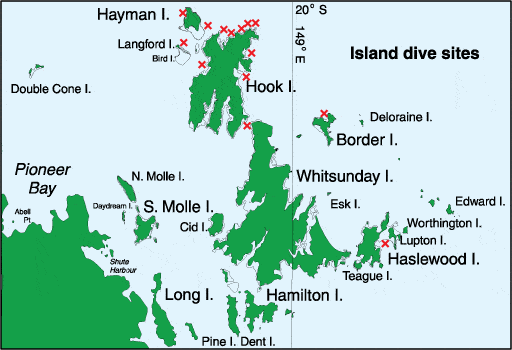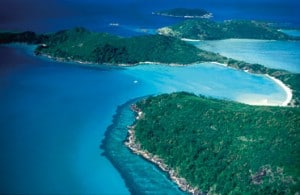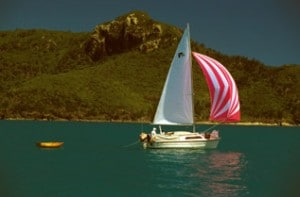Best Dive Sites in the Whitsunday Islands
Dive and Snorkel Sites
Diving and snorkelling in the area can be done either around the Whitsunday Islands, or further out to sea on the Barrier Reef proper. The quality of the reef and wildlife is better for the latter.
Whitsunday Island Dive Sites
Bird Island
Visibility: 2-12 metres
Diving depth: 2-15 metres
Bottom: Rock in the shallows down to 6-8 metres, then dropping off to coral rubble and silty sand.
This site very open to currents; best to plan a drift dive or stay close to the island. Interesting rock formations down to 8 metres; shallow caves, ledges and gullies. Not a lot of coral, but the fish life can be quite good with large cod, sweetlip and trevally.
Snorkelling: Only mediocre.
Black Island (West Reef)
Visibility: 2-10 metres
Diving depth: 3-12 metres
Bottom: Small, scattered coral heads on a silty sand bottom gently sloping from the beach to 15 metres.
An easy shore dive (as the majority of interesting corals are very near the shore) from the northwestern corner of Black Island. Fish life rather small, but colourful. Current can be strong offshore, particularly near the northern end of the beach.
Snorkelling: Yes, but a bit deep at high tide.
Border Island (Cataran Bay)
Visibility: 2-12 metres
Diving depth: 2-12 metres
Bottom: Good hard coral cover in shallow water to 6 metres with patches of sand. Below 6 metres predominantly small coral heads, coral rubble and silty sand.
Best diving on either side of entrance into bay. Coral reefs are relatively shallow, dominated by large beautiful plate coral. From the top of reef a small wall drops down to 6 metres. Scattered coral bommies continue down to 12 metres. Plenty of gullies and ledges to explore. Fish life average, though some larger sweetlip and cod can be found under the ledges. Inside the bay, current is minimal; however, beware strong currents at the entrance, particularly off the northwest tip.
Snorkelling: Coral very shallow, making for easy snorkelling.
Haslewood Island (Waite Bay)
Visibility: 3-15 metres
Diving depth: 3-18 metres
Bottom: Very good coral cover with scattered small bommies and sand patches in shallow water gradually sloping from 3 metres to 6 metres. Good wall down to 12-18 metres then coral rubble and silty sand. Very diverse dive site. A maze of interesting coral bommies in shallow water from 6 metres. Good quality coral. A descent wall dive from 6 metres to as deep as 18 metres on reef edge. Again, good coral cover, plenty of gullies and ledges to explore. Good fish life of all sizes. Watch for manta rays in the winter months, May to September. Current is not normally a problem except during spring tides. Bay is open to south-easterlies. Can only be dived during light winds or northerlies.
Snorkelling: Best in shallows near beach, though is also very good for the intrepid snorkeller who prefers something a bit deeper on the reef edge.
Hayman Island (Dolphin Point)
Visibility: 3-15 metres
Diving depth: 5-18 metres
Bottom: Rugged terrain of coral outcrops and huge boulders set on coral rubble and sand.
An unusual dive amongst house-sized rock slabs making for great exploration. Large coral bommies at 5-15 metres add to the diversity of the dive. Excellent large fish life for island diving, including trevally, mackerel, barracuda and the odd shark. This is a relatively deep dive with potential currents near the point. Good anchorage in all but northerly winds.
Snorkelling: Not really. Too deep.
Hayman Island (East Reef)
Visibility: 5-15 metres
Diving depth: 2-12 metres
Bottom: Very good coral cover in shallow water (6-8 metres) cut with numerous small canyons. Small bommies and sand-coral rubble from 8 to 15 metres.
A very pretty shallow dive and snorkel site. The shallow coral cover is dominated by large plates, creating numerous small canyons and ledges which make for interesting exploration. Plenty of small, friendly reef fish. Access to this site is difficult due to its exposure to wind from every direction and to currents. A site for very calm days at slack tide.
Snorkelling: Excellent shallow coral.
Hook Island (Alcyonaria Point)
Visibility: 3-15 metres
Diving depth: 3-18 metres
Bottom: Good coral cover with patches of coral rubble and silty sand.
Excellent coral and fish life, particularly along the shallow ledge that runs along the point to Flat Rock. Plate corals dominate the shallow water. Ledge drops vertically with wall penetrated by numerous gullies and small caves. Many colourful soft corals at 10 metres, hence the site name. Large wrasse, cod and sweetlip found at depth. Current can be a problem, particularly at midtide. Anchorage is difficult due to drop-off. Exposed to northerlies and strong south-easterlies.
Snorkelling: Excellent shallow corals but prone to strong current.
Hook Island (Butterfly Bay)
Visibility: 2-10 metres
Diving depth: 5-12 metres
Bottom: Coral cover with large patches of coral rubble and silty sand.
This popular bareboat anchorage offers coral outcrops with shallow walls. Many small, colourful fish. Best of the bommies is found in the centre of the bay, though difficult to locate at high tide. Tidal currents can be a problem as one moves away from the bay edge towards the centre.
Snorkelling: Only along the bay edge or just off the beach.
Hook Island (Mackerel Bay)
Visibility: 2-10 metres
Diving depth: 2-12 metres
Bottom: Good coral cover in shallow water, dropping off to scattered bommies at 7-12 metres.
A dive that is better at some times than at others depending upon visibility. This is a popular dive site during northerlies when most of the more popular sites are untenable. A relatively shallow dive through a mace of coral bommies, which form shallow canyons, ledges and swim-throughs. The fish life is medium in size and quite good. Exposed to southerly winds.
Snorkelling: Visibility adversely affected by the tide. Best during neap tides.
Hook Island (The Pinnacles)
Visibility: 3-15 metres
Diving depth: 3-18 metres
Bottom: Near solid coral cover in shallow water, breaking up into scattered but dense bommies from 5 to 18 metres. Below 18 metres only coral rubble and sand with the odd small coral head.
Arguably the best dive site in the Whitsunday islands – certainly the best hard corals which compare favourably to the Great Barrier Reef. The best dive would be off the western beach, adjacent to the Woodpile and swim east at a depth of 7-15 metres. Large coral bommies dominate the terrain, reaching nearly to the surface. As usual, acropora corals are everywhere but huge porites corals in the shape of huge boulders and massive towers can also be seen. The fish life is medium in size and average in quality. Masts rays are very common in the cooler months, May to September. In the shallow water, particularly off the western beach, the coral cover is nearly solid, mostly staghorn, with only a few sandy patches. The quality of the corals diminishes the further east one goes (towards the rock pinnacles). This site is open to northerly winds and swell from strong south-easterlies.
Snorkelling: Some of the best in the Whitsundays just off the western beach.
Hook Island (Saba Bay)
Visibility: 2-12 metres
Diving depth: 2-15 metres
Bottom: Good coral cover in shallow water, dropping of to scattered bommies at 7-12 metres
As with Mackerel Bay, this is another popular dive site during northerly winds which can be better at some times than others depending upon visibility. The northern end of the bay is studded with numerous small bommies in relatively shallow water, dropping down to 10-15 metres with scattered bommies among coral rubble and sand. Plenty of shallow canyons, ledges and swimthroughs. The fish are small- to medium-sized and in good numbers. Visibility is adversely affected by tide. Best dives during neap tides. Exposed to southerly winds.
Snorkelling: Interesting bommies on both sides of bay.
Hook Island (Stonehaven Anchorage)
Visibility: 2-10 metres
Diving depth: 2-12 metres
Bottom: Scattered small coral heads with a silty sand bottom.
This site offers interesting shallow diving with lots of small marine life including damselfishes. Christmas-tree worms and nudibranches. The coral heads are small but diverse. The visibility is very much controlled by the tides, but is best during the reaps.
Snorkelling: Only at high tide, as can be quite shallow.
Hook Island (The Woodpile)
Visibility: 4-15 metres
Diving depth: 5-30 metres
Bottom: Rock wall drop-off with scattered deep coral and sandy bottom. The unusual rock formation known as the Woodpile has created the best wall dive in the Whitsunday islands. The wall drops down to nearly 30 metres on the point. Best to start the dive about halfway between the beach and the point. Here the wall is covered in soft corals down to 5-7 metres. Below 7 metres, the wall is somewhat devoid of corals but provides some excellent exploring, with large overhanging ledges and shallow caves. Some fairly large black coral trees can be found between 10 and 15 metres. Back away from the wall is a maze of coral bommies, including some large porite corals. Approaching the point the landscape becomes rather barren due to strong currents – an area to be avoided. This site is exposed to northerlies, and swell from strong south-easterlies can make anchoring quite uncomfortable.
Snorkelling: No.
Langford Island (Langford Reef North)
Visibility: 2-10 metres
Diving depth: 3-15 metres
Bottom: Scattered small coral bommies on sandy bottom, gradually sloping from shore to 15 metres. Below 15 metres mostly coral rubble and silty sand.
A very popular day-trip destination for sailors, snorkellers and divers. Best diving is found on north-western end of beach, where current is strongest at mid-tide. Scattered bommies offer an interesting maze to explore. Some shallow walls at the eastern end of the island. The majority of fish life is small but abundant. Expert to encounter tidal currents at all times except slack water. Reasonable protection from all but the strongest wind condition.
Snorkelling: Just offshore along the beach; best towards the island.
Whitsunday Island (The Gardens)
Visibility: 4-15 metres
Diving depth: 5-15 metres
Easy, shallow dive just off Hook Island, very near the Underwater Observatory. Coral cover dominated by large plate corals. Plenty of small friendly reef fish looking for a handout. Occasionally, large pelagic fishes will cruise through. Excellent protection in all wind conditions. Current can be a problem during spring tides.
Snorkelling: Watch current during big tides.





